Damascus Gate: A Major Portal to the Old City
Introduction
The Damascus Gate, known as “Sha’ar Shkhem” in Hebrew and “Bāb al-ʿĀmūd” in Arabic, is one of the eight gates in the Old City of Jerusalem and one of its main ones. It has been a significant landmark and a point of convergence for various cultures and epochs.
Location
The Damascus Gate is situated on the northwestern side of the Old City of Jerusalem. It connects to a highway leading to Nablus, known in the Hebrew Bible as Shechem or Sichem, and from there, historically, to the capital of Syria, Damascus.
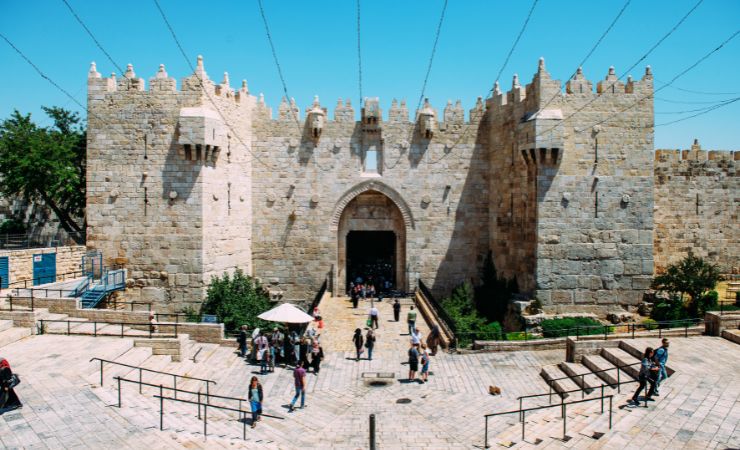
Damascus Gate: A Deeper Dive into History and Archaeology
A location that symbolizes its importance
The Damascus Gate is located on the northwestern side of the Old City of Jerusalem. It connects to a highway leading to Nablus, known in the Hebrew Bible as Shechem or Sichem, and from there, historically, to the capital of Syria, Damascus. This strategic location made it a crucial point of entry and exit, connecting Jerusalem to other significant cities in the region.
Aelia Capitolina Period
During the Roman and Byzantine periods, an earlier gate dating back to the time of Roman Emperor Hadrian (129/130 CE) was present beneath the current gate. This gate was initially built as a free-standing triumphal gate because the walls, especially those in the western hill, were destroyed during the First Jewish-Roman War in 70 CE. In the absence of walls, Jerusalem was protected by a light garrison of the Tenth Legion, that prevented Jews from returning to the city. Roman enforcement of this prohibition continued through the 4th century after which the protective walls around Jerusalem were built towards the end of the 3rd or the beginning of the 4th century.
Two other triumphal gates from the time of Emperor Hadrian are the Ecce Homo Arch, and the triumphal arch located at the Alexander Nevsky Church in the Old City.
The gate was part of the Roman city of Aelia Capitolina, which was built on the ruins of Jerusalem, which had been destroyed during the First Jewish-Roman War in 70 CE. Aelia Capitolina was a Roman colony, founded by Emperor Hadrian during his visit to Judaea in 129/130 CE. The urban plan of Aelia Capitolina was that of a typical Roman town wherein main thoroughfares crisscrossed the urban grid lengthwise and widthwise. The urban grid was based on the usual central north–south road (Cardo Maximus) and central east–west route (Decumanus Maximus).
The gate, known as the “Gate of the Column” during this period, was named after a Roman column that stood in the square behind the gate. The column, topped by a statue of Emperor Hadrian, was a symbol of the Roman victory over the Jews.
Crusaders Period
During the Crusader era, the city walls were breached and subsequently reconstructed after the city was retaken. Among the three gates in the northern wall, the Damascus Gate persisted as the primary entry point on that side of the city. In this period, a series of rooms was constructed adjacent to the outer facade of the gate, effectively blocking the entrances and requiring the use of internal openings. These rooms served as storage spaces.
Ottoman Period
The current form of the Damascus Gate was constructed in 1537 under the rule of Suleiman the Magnificent. The gate was built as part of the renovation of Jerusalem’s city walls, which were in a state of disrepair at the time.
The renowned architect Sinan designed the Damascus Gate, drawing inspiration from the existing ancient Roman ruins. He opted to discard the later medieval additions, replacing the original three-opening gate with a single, elevated gateway. Since its construction, the structure of the gate has remained largely unchanged.
The Damascus Gate was built with a high degree of ornamentation, reflecting the grandeur and prosperity of the Ottoman Empire at the time. The gate’s design includes a number of distinctive features, including a crenellated turret, machicolations (openings through which defenders could drop objects on attackers), and a muqarnas (a type of ornamented vaulting) above the central arch.
Above the gate, there is an inscription in Arabic that commemorates its construction under the rule of Suleiman the Magnificent in 1537. The gate leads into a passage that turns sharply to the west, a defensive feature designed to slow down any attackers who managed to breach the gate. The passage is covered by a cross-vaulted ceiling and lined with several chambers, which were originally used as guardrooms.
Israeli Period
Starting in the late 1970s, architects Peter Bugod and Eunice Figueiredo undertook a restoration project in collaboration with the Jerusalem Foundation. The endeavor was carried out in three distinct phases.
The initial phase, in 1981, addressed various shortcomings in the gate’s outer area, such as inadequate approaches for merchandise delivery, insufficient parking facilities, limited access and circulation, and overall neglect. To tackle these issues, the architects devised a solution that involved transforming the entrance into a plaza designed like an amphitheater. This redesign aimed to create a more functional and aesthetically pleasing space for visitors and locals alike.
During the second phase of improvements in 1982, the focus shifted to the street and shops located inside the gate. The architects conducted extensive renovations, including the replacement of roofs, repair of storefronts, installation of stone paving, and upgrading sewage, water, electricity, and drainage systems.
Finally, the third phase, carried out in 1985, concentrated on the preservation and excavation of the archeological remains beneath the gate. Notably, various Roman relics were discovered, including a previous gate, a guardroom, and a staircase leading to the top of the rampart. These historical artifacts were preserved and opened to the public, forming an archaeological garden that provided valuable insights into the area’s rich history.
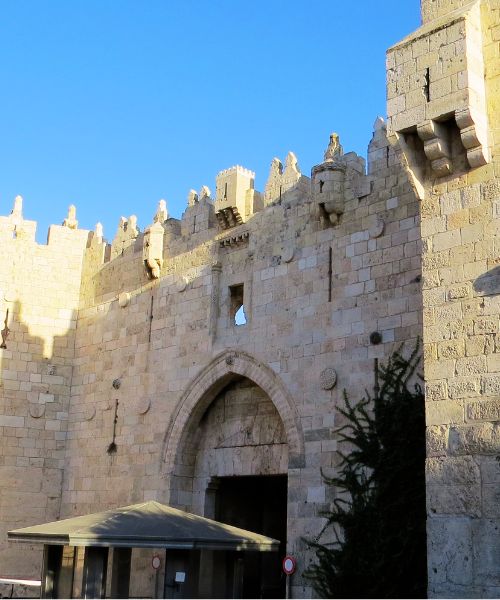
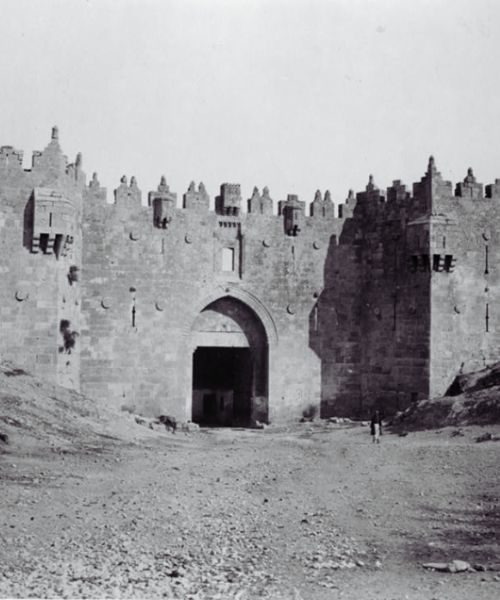
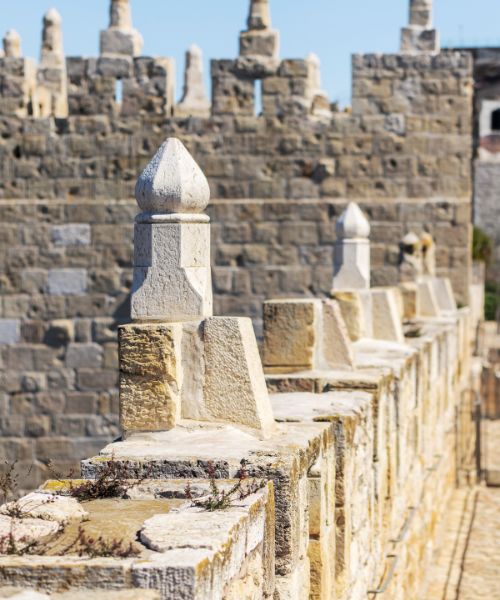
The Current Visitor Experience
The gate is flanked by two towers, each equipped with machicolations. It offers access from the north to the Arab bazaar (souk) in the Muslim Quarter. Unlike the Jaffa Gate, where stairs rise towards the gate, at the Damascus Gate, the stairs descend towards the gate.
Until the Six-Day War in 1967, a battlemented turret stood prominently over the gate, but it suffered damage during the conflict that engulfed the Old City. In 2011, Israeli authorities undertook the restoration of the turret, including its arrow slit, guided by early 20th-century photographs taken during the British Mandate of Jerusalem. The restored turret is secured to the wall with eleven anchors and is topped with four stone slabs forming the battlements.
The Damascus Gate boasts impressive Ottoman-era architecture, as well as the remains of the earlier Roman gate from the time of the Emperor Hadrian in the second century. The area around the gate is often bustling with activity, with vendors selling a variety of goods in the nearby Arab bazaar. The gate is also a starting point for exploring the many historical and religious sites within the Old City of Jerusalem.
Sources and additional reading:
Damascus Gate – Wikipedia
Architectural and Chronological Aspects of the Ancient Damascus Gate Area
The Damascus Gate Section – Israel Antiquities Authority
Jerusalem Foundation – The Damascus Gate
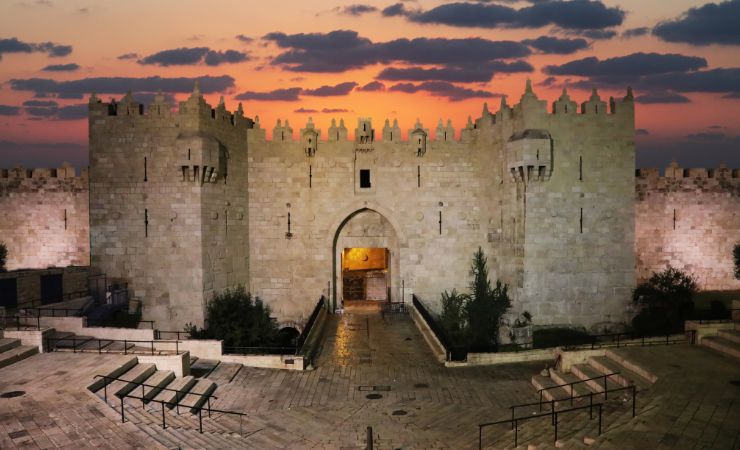
Nearby Sites
- The Garden Tomb: A rock-cut tomb in Jerusalem which many Christians believe to be the site of the burial and resurrection of Jesus Christ.
- Herod’s Gate: Also known as Flower Gate, it leads into the Muslim Quarter of the Old City, and its name is derived from a rosette carved into the gate’s facade.
- The Roman Cardo: The main street in the Byzantine era of Jerusalem, it was the economic heart of the city and is now a significant archaeological site.
- King Hezekiah’s Tomb: Traditionally believed to be the burial place of the biblical King Hezekiah, it is an ancient Jewish funerary monument located outside the Old City of Jerusalem.



